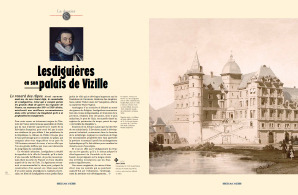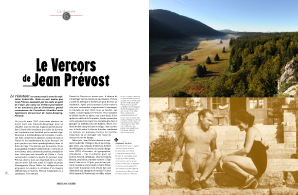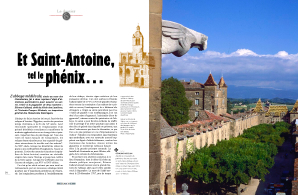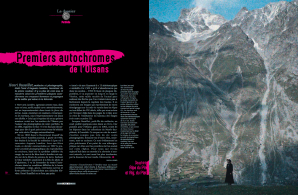Translations: Cary Bartsch
Written for people looking for information with meaning, L’Alpe is the first review devoted to the many cultures and heritages of Alpine Europe. Its ambition is to provide information, language barriers not withstanding. As your guide, L’Alpe looks at the people who, from the meandering Danube to the Rhône, have adapted to an exceptional climate. A cross between a book and a magazine, it draws on the first to provide background documents on a main theme, supported by rigorous analysis, an insistence on quality and the notoriety of renown authors. From the second, it adopts a quarterly rhythm for regular contributions to current debates, rich illustrations, the insatiable curiosity of its journalists and a necessarily didactic approach. Though rigorous in its approach to knowledge, L’Alpe is not a scientific journal. It calls on the contributions of history, geography, archaeology, ethnology, etc. to shed light on the meaning of the traces left by man on the mountain environment. And it is also open to current debates on the future of the Alps and other mountains in the world.
From the lake of Paladru to ARC-Nucléart
Atoms and art are not necessarily antinomic. Proof is the ARC-Nucléart technological adventure in Grenoble. The workshop for the restoration and conservation of artwork brings together a wide array of skills and is truly unique. It was created by a physicist to save the art collections of the Isère department, notably those from the Paladru lake sites, and is now acknowledged worldwide for its bold and inventive techniques.
Caius Iulius Pacatianus, a Gaul in the service of the Romans
Along the Rhône River, in the small town of Vienne, formerly the capital of those parts of Gaul beyond the Alps, a remarkable person was born. A member of the Allobroge tribe, he became a military advisor to the Roman emperor and launched a brilliant career that took him to the Middle East and Africa. An exceptional destiny.
 Lesdiguières in his palace in Vizille
Lesdiguières in his palace in Vizille
The fox of the Alps. That was how the High Constable de Lesdiguières was known, even during his lifetime. The man, who was one of the greatest military leaders in France during the period before and after 1600, deserves more recognition from the Dauphiné province that he so profoundly transformed.
Innovation galore?
Isère is said to be particularly innovative in the social field. Does a militant, revolutionary spirit reign in the department? Though the department has occasionally taken a leading role, the image must be tempered somewhat. What follows is a historical overview to separate myth from fact.
 The Vercors of Jean Prévost
The Vercors of Jean Prévost
The Resistance fighter was known by the name of Captain Goderville. What is less known is that Jean Prévost, who was assassinated by the Nazis at the foot of the mountains, was also a brilliant journalist and a lover of literature, an expert on Stendhal (from Grenoble) and also the discoverer of Saint-Exupéry. A portrait.
Monuments (wo)man in another form of resistance
George Clooney met Rose Valland. She was born in the Isère department and, during the Nazi occupation, worked as a conservator at the Jeu de Paume museum, where she helped in saving tens of thousands of works of art. Cate Blanchett portrays her in the film Monuments Men, directed by Clooney and coming to cinemas in March 2014.
 Saint-Antoine, a phoenix
Saint-Antoine, a phoenix
Twice in the past, the medieval abbey, located in the Chambaran region, was saved because two determined men took a particular interest in it. Étienne Galland, an Abbot in the 1700s, and writer Prosper Mérimée, an inspector general for the Historic Monuments administration.
Berlioz and the fantastic Isère
Do geniuses have roots? By continuously highlighting the universal character of their work and, even more importantly, studying it from an academic point of view, we forget that even geniuses are born somewhere. And, for musicians, that they lived in a soundscape of which traces may be found in their work. A demonstration with the Fantastic Symphony.
Painting light
The landscapes in northern Isère provided artists with a new source of inspiration in the 1800s. Corot, Courbet, Daubigny and above all Auguste Ravier, a forerunner to impressionism, all set up their easel between Crémieu and Morestel.
Discovering the many cultural sides
In Isère, even more than elsewhere in the Alps, economic development created links between the valleys and the summits, notably thanks to the invention of hydropower. But to truly discover the culture of the area, one must also visit many other sites bearing witness to the genius of the people born or living there.
Captains of industry
Grenoble and its area were recently ranked as the fifth most innovative city in the world by the magazine Forbes. That image of innovation is indeed one of the most commonly used in promoting the site. But few people know much about how that image gained traction and what stands behind it.
Who “invented” skiing?
The Belledonne range is thought to be the site of the first attempts at skiing in France. Even as early as 1878, according to Henri Duhamel who posed as a pioneer in the field (but 30 years later). Though he may have rewritten history to his own liking, this multi-facetted man was nonetheless a true initiator.
 Portfolio: first autochromes in the Oisans
Portfolio: first autochromes in the Oisans
Henri Bussillet, a doctor and photographer, was a friend of Auguste Lumière, the inventor of colour photography. Over a century ago, he tested the very first autochrome plates by taking photos of the people and landscapes in the valley leading to La Bérarde.
Petzl from deep cave to mountain top
The Chartreuse range was the playground and starting point for this well-known manufacturer of mountaineering equipment. Starting with the fascination of the original founder, Fernand, for the caves under the Dent de Crolles to the high walls in North America, and spanning acrobatic work conditions at heights and mountain rescue equipment, this is the story of a company with strong roots in its homeland.
Practical information
The Isère department has a wide array of wonderful museums. We have listed here particularly those related to the articles in this issue.


